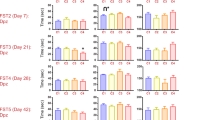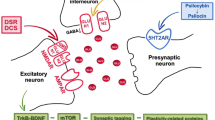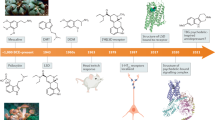Abstract
The evidence for the involvement of cholinergic muscarinic receptors in mania and depression is reviewed. Small pilot trials with cholinesterase inhibitors and muscarinic agonists suggest that stimulation of muscarinic receptors may produce an antimanic effect, possibly by activation of muscarinic M4 receptors. It is concluded that it is not likely that currently used mood stabilizers, such as lithium, valproic acid and carbamazepine, work directly through muscarinic receptor mechanisms. Furthermore, the evidence indicates that antipsychotic agents used for mania are working through the common mechanism of antagonism of dopamine D2 receptors, and interactions with muscarinic receptors do not play a key role. Finally, it is hypothesized that olanzapine has robust antimanic activity, due to blockade of dopamine D2 receptors and antagonism of other monoaminergic receptors. Olanzapine may normalize mood due to antidepressant-like activities, such as 5-HT2A receptor antagonism and increasing cortical norepinephrine and dopamine.
This is a preview of subscription content, access via your institution
Access options
Subscribe to this journal
Receive 12 print issues and online access
$259.00 per year
only $21.58 per issue
Buy this article
- Purchase on Springer Link
- Instant access to full article PDF
Prices may be subject to local taxes which are calculated during checkout
Similar content being viewed by others
References
Weissman MM, Leaf PJ, Tischler GL et al. Affective disorders in five United States communities Psychol Med 1988 18: 141–153
Lenox RH . Role of receptor coupling to phosphoinositide metabolism in the therapeutic action of lithium Adv Exp Med Biol 1987 221: 515–530
Janowsky DS, Overstreet DH . The role of acetylcholine mechanisms in mood disorders In: Bloom FE, Kupfer DJ (eds) Psychopharmacology: The Fourth Generation of Progress Raven Press: New York 1995 pp 945–956
Hulme EC, Birdsall NJ, Buckley NJ . Muscarinic receptor subtypes Ann Rev Pharmacol Toxicol 1990 30: 633–673
Felder CC . Muscarinic acetylcholine receptors: signal transduction through multiple effectors FASEB J 1995 9: 619–625
Matsui M, Motomura D, Karasawa H et al. Multiple functional defects in peripheral autonomic organs in mice lacking muscarinic acetylcholine receptor gene for the M3 subtype Proc Natl Acad Sci U S A 2000 97: 9579–9584
Stengel PW, Gomeza J, Wess J, Cohen ML . M2 and M4 receptor knockout mice: muscarinic receptor function in cardiac and smooth muscle in vitro J Pharmacol Exp Ther 2000 292: 877–885
Levey AI . Immunological localization of m1–m5 muscarinic acetylcholine receptors in peripheral tissues and brain Life Sci 1993 52: 441–448
Hamilton SE, Loose MD, Ming Q et al. Disruption of the m1 receptor gene ablates muscarinic receptor-dependent M current regulation and seizure activity in mice Proc Natl Acad Sci U S A 1997 94: 13311–13316
Marino MJ, Rouse ST, Levey AI, Potter LT, Conn PJ . Activation of the genetically defined m1 muscarinic receptor potentiates N-methyl-D-aspartate (NMDA) receptor currents in hippocampal pyramidal cells Proc Natl Acad Sci U S A 1998 95: 11465–11470
Gomeza J, Shannon H, Kostenis E et al. Pronounced pharmacologic deficits in M2 muscarinic acetylcholine receptor knockout mice Proc Natl Acad Sci U S A 1999 96: 1692–1697
Hemrick-Luecke SK, Felder CC, Evans DE, Wess J, Bymaster FP . Effect of BuTAC on the elevation of serum corticosterone concentrations in M2 and M4 muscarinic acetylcholine receptor knockout mice Soc Neurosci Abstr 2000 26: 1644
Zhang L, Wess J, Gomeza J, Felder CC, Bymaster FP . M2 Muscarinic receptors are the predominant inhibitory autoreceptors in mouse striatum: a study in muscarinic receptor knockout mice Soc Neurosci Abstr 1999 25: 1724
Gomeza J, Zhang L, Kostenis E et al. Enhancement of D1 dopamine receptor-mediated locomotor stimulation in M4 muscarinic acetylcholine receptor mice Proc Natl Acad Sci U S A 1999 96: 10483–10488
Bymaster FP, Shannon HE, Rasmussen K et al. Unexpected antipsychotic-like activity with the muscarinic agonist receptor ligand (5R,6R)6-(3-propylthio-1,2,5-thiadiazol-4-yl)-1-azabicyclo[3.2.1]octane Eur J Pharmacol 1998 358: 109–119
Bymaster FP, Shannon HE, Rasmussen K et al. Potential role of muscarinic receptors in schizophrenia Life Sci 1999 64: 527–534
Yeomans J . Role of tegmental cholinergic neurons in dopaminergic activation, antimuscarinic psychosis and schizophrenia Neuropsychopharmacology 1995 12: 3–16
Hasey G, Hanin I . The cholinergic-adrenergic hypothesis of depression reexamined using clonidine, metoprolol, and physostigmine in an animal model Biol Psychiatry 1991 29: 127–138
Overstreet DH, Janowsky DA, Gillin JC, Shiromani PJ, Sutin EL . Stress-induced immobility in rats with cholinergic supersensitivity Biol Psychiatry 1986 21: 657–664
Dilsaver SC . Cholinergic-monoaminergic interactions in the pathophysiology of the affective disorders? Int Clin Psychopharmacol 1986 1: 181–198
Roundtree DW, Nevin S, Wilson A . The effects of diisopropylfluorophosphonate in schizophrenia and manic depressive psychosis J Neurol Neurosurg Psychiatry 1971 133: 47–62
Safer DJ, Allen RP . The central effects of scopolamine in man Biol Psychiatry 1971 3: 347–355
Pullen GP, Best NR, Maguire J . Anticholinergic drug abuse: a common problem? Br Med J (Clin Res Ed) 1984 289: 612–613
Janowsky DS, El-Yousef MK, Davis JM, Sekerke HJ . A cholinergic-adrenergic hypothesis of mania and depression Lancet 1972 2: 632–635
Davis KL, Berger PA, Hollister LE, Defraites E . Physostigmine in man Arch Gen Psychiatry 1978 35: 119–122
Risch S, Siever LJ, Gillin JC et al. Differential mood effects of arecoline in depressed patients and normal volunteers Psychopharmacol Bull 1983 19: 696–698
Davis KL, Hollander E, Davidson M, Davis BM, Mohs RC, Horvath TB . Induction of depression with oxotremorine in patients with Alzheimer's disease Am J Psychiatry 1987 144: 468–471
Gillin JC, Salin-Pascual R, Velazquez-Moctezuma J, Shiromani P, Zoltoski R . Cholinergic receptor subtypes and REM sleep in animals and normal controls Prog Brain Res 1993 98: 379–387
Janowsky DS, Risch SC, Kennedy B, Ziegler M, Huey LY . Central muscarinic effects of physostigmine on mood, cardiovascular function, pituitary and adrenal neuroendocrine Psychopharmacology 1986 89: 150–154
Riemann D, Berger M . Sleep, age depression and the cholinergic induction test with RS 86 Prog Neuropsychopharmacol Biol Psychiatry 1992 16: 311–316
O'Keane V, O'Flynn K, Lucey J, Dinan TG . Pyridostigmine-induced growth hormone responses in healthy and depressed subjects: evidence for cholinergic supersensitivity in depression Psychol Med 1992 22: 55–60
Sokolski KN, DeMet EM . Cholinergic sensitivity predicts severity of mania Psychiatry Res 2000 95: 195–200
Bodick NC, Offen WW, Levey AI et al. The effects of xanomeline, an M1-selective muscarinic agonist, on cognitive and behavioral symptoms in Alzheimer's disease Arch Neurol 1997 54: 465–473
Burt T, Sachs GS, Demopulos C . Donepezil in treatment-resistant bipolar disorder Biol Psychiatry 1999 45: 959–964
Janowsky DS, El-Yousef MK, Davis JM, Sekerke HJ . Antagonistic effects of physostigmine and methylphenidate in man Am J Psychiatry 1973 130: 1370–1376
Carroll BJ, Fraser A, Schless A, Mendels J . Cholinergic reversal of manic symptoms Lancet 1973 1: 427–428
Cohen BM, Lipinski JF, Altesman RF . Lecithin in the treatment of mania: double-blind, placebo-control trials Am J Psychiatry 1982 139: 1162–1164
Leiva DB . The neurochemistry of mania: a hypothesis of etiology and rationale for treatment Prog Neuoropsychopharmacol Biol Psychiatry 1990 14: 423–429
Stoll AL, Sachs GS, Cohen BM, Lafer B, Christensen JD, Renshaw PF . Choline in the treatment of rapid-cycling bipolar disorder Biol Psychiatry 1996 40: 382–388
Bunney WE Jr, Garland-Bunney BL . Mechanisms of action of lithium in affective illness: basic and clinical implications In: Meltzer HY (ed) Psychopharmacology: Third Generation of Progress Raven Press: New York 1987 pp 553–565
Dilsaver SC . Lithium's effects on muscarinic receptor binding parameters: a possible relationship to therapeutic efficacy? Biol Psychiatry 1984 19: 1551–1565
Jope RS . Effects of lithium treatment in vitro and in vivo on acetylcholine metabolism in rat brain J Neurochem 1979 33: 487–495
Gao X-M, Fumamauchi F, Chuang D-M . Long-term biphasic effects of lithium treatment on phospholipase C-coupled M3 muscarinic acetylcholine receptors in cultured cerebellar cells Neurochem Int 1993 22: 395–403
Manji HK, Chen G, Hsiao JK, Risby ED, Masara MI, Potter WZ . Regulation of signal transduction pathways by mood-stabilizing agents: implications for the delayed onset of therapeutic efficacy J Clin Psychiatry 1996 57 (Suppl 13): 34–46
Tohen M, Zarate CA . Antipsychotic agents and bipolar disease J Clin Psychiatry 1998 59 (Suppl 1): 38–48
Janicak PG, Newman RH, Davis JM . Advances in the treatment of mania and related disorders: a reappraisal Psychiatric Annals 1992 22: 92–103
Goodwin FK, Zis AP . Lithium in the treatment of mania: comparisons with neuroleptics Arch Gen Psychiatry 1979 36: 840–844
Garfinkel PE, Stancer HG, Persad E . A comparison of haloperidol, lithium carbonate and their combination in the treatment of mania J Affect Disord 1980 2: 279–288
Ahlfors UG, Baastrup C, Dencker CA et al. Flupenthixol decanoate in recurrent manic-depressive illness. A comparison with lithium Acta Psychiatr Scand 1981 64: 226–237
Nasrallah HA, Church CM, Hamdan-Allan GA . Higher frequency of neuroleptic-induced dystonia in mania than schizophrenia Am J Psychiatry 1988 145: 1455–1456
White E, Cheung P, Silverstone T . Depot antipsychotics in bipolar affective disorder Int Clin Psychopharmacol 1993 8: 119–122
Ghaemi SN, Goodwin FK . Use of atypical antipsychotic agents on bipolar and schizoaffective disorders: review of the empirical literature J Clin Psychopharmacol 19: 354–361
Tohen M, Sanger TM, McElroy SL et al The Olanzapine HGEH Study Group. Olanzapine versus placebo in the treatment of acute mania Am J Psychiatry 1999 156: 702–709
Berk M, Ichim L, Brook S . Olanzapine compared to lithium in mania: a double-blind randomized controlled trial Int Clin Psychopharmacol 1999 14: 339–343
Bymaster FP, Calligaro DO, Falcone JF et al. Radioreceptor binding profile of the atypical antipsychotic olanzapine Neuropsychopharmacology 1996 14: 87–96
Bymaster FP, Hemrick-Luecke SK, Perry KW, Fuller RW . Neurochemical evidence for antagonism by olanzapine of dopamine, serotonin α1-adrenergic and muscarinic receptors in vivo in rats Psychopharmacology 1996 124: 87–94
Bymaster FP, Moore NA, Nakazawa T . Review of the preclinical pharmacology of olanzapine: a MARTA class antipsychotic Japan J Clin Psychopharmacol 1999 2: 885–911
Roth BL, Craigo SC, Choudhary MS et al. Binding of typical and atypical antipsychotic agents to 5-hydroxytryptamine-6 and 5-hydroxytryptamine-7 receptors J Pharmacol Exp Ther 1994 268: 1403–1410
Fibiger HC . Neurobiology of depression: focus on dopamine: depression and mania: from neurobiology to treatment In: Gessa G, Fratta W, Pani L, Serra G (volume eds); Costa E, Greengard P (series eds) Advances in Biochemical Psychopharmacology Vol 49: Raven Press: New York 1995 pp 1–17
Bymaster FP, Breier A, Tollefson GD, Herrara JM, Tran PV . Olanzapine belongs to a new multi-acting-receptor-targeted-antipsychotic (MARTA) class of antipsychotics In: Tran PV, Bymaster FP, Tye N, Herrara JM, Breier A, Tollefson GD (eds) Olanzapine (Zyprexa): A Novel Antipsychotic Lippincott Williams and Wilkens Healthcare: Philadelphia 2000 pp IX–XII
Mørk A, Jensen JB . Effects of lithium and other mood-stabilizing agents on the cyclic adenosine monophosphate signaling system in the brain In: Manji HK, Bowden CL, Belmaker RH (eds) Bipolar Medications: Mechanisms of Action American Psychiatric Press: Washington, DC 2000 pp 109–128
Stefanski R, Goldberg SR . Serotonin 5-HT2 receptor antagonists-potential in the treatment of psychiatric disorders CNS Drugs 1997 5: 388–409
Li XM, Perry KW, Wong DT, Bymaster FP . Olanzapine increases in vivo dopamine and norepinephrine release in rat prefrontal cortex, nucleus accumbens and striatum Psychopharmacology 1998 136: 153–161
Ichikawa J, Meltzer HY . Valproate and carbamazepine increased prefrontal dopamine release by 5-HT1A receptor activation Eur J Pharmacol 1999 380: R1–R3
Baxter LR, Schwartz JM, Phelps ME et al. Reduction of prefrontal cortex glucose metabolism common to three types of depression Arch Gen Psychiatry 1989 46: 243–250
Robertson GS, Fibiger HC . Effects of olanzapine on regional c-Fos expression in rat forebrain Neuropsychopharmacology 1996 14: 105–110
Bolden C, Cusack B, Richelson E . Antagonism by antimuscarinic and neuroleptic compounds at the five cloned human muscarinic cholinergic receptors expressed in Chinese hamster ovary cells J Pharmacol Exp Ther 1992 260: 576–580
Bymaster FP, Falcone JF . Decreased binding affinity of olanzapine and clozapine for human muscarinic receptor subtypes in intact clonal CHO cells in physiological medium Eur J Pharmacol 2000 390: 245–248
Zorn SH, Jones SB, Ward KM, Liston DR . Clozapine is a potent and selective muscarinic M4 receptor agonist Eur J Pharmacol 1994 269: R1–2
Zeng XP, Le F, Richelson E . Muscarinic m4 receptor activation by some atypical antipsychotic drugs Eur J Pharmacol 1997 321: 349–354
Olianas MC, Maullu C, Onali P . Mixed agonist-antagonist properties of clozapine at different human cloned muscarinic receptor subtypes expressed in Chinese hamster ovary cells Neuropsychopharmacology 1999 20: 263–270
Bymaster FP, Nelson DL, DeLapp NW et al. Antagonism by olanzapine of dopamine D1, serotonin2, muscarinic, histamine H1 and α1-adrenergic receptors in vivo Schizo Res 1999 37: 107–122
Zhang W, Bymaster FP . The in vivo effects of olanzapine and other antipsychotic agents in receptor occupancy and antagonism of dopamine D1, D2, D3, 5HT2A and muscarinic receptors Psychopharmacology 1999 141: 267–278
Felder CC, Bymaster FP, Ward J, DeLapp N . Therapeutic opportunities for muscarinic receptors in the central nervous system J Med Chem 2000 43: 4333–4353
Shannon HE, Bymaster FP, Calligaro DO et al. Antipsychotic-like pharmacologic profile of the muscarinic agonist BuTAC Schizo Res 1999 36: 314–315
Shannon HE, Rasmussen K, Hart JC et al. Xanomeline, an M1/M4 preferring muscarinic cholinergic receptor agonist, produces antipsychotic activity in rats and mice Schizo Res 2000 42: 249–259
Perry KW, Nisenbaum LK, George CA, Shannon HE, Felder CC, Bymaster FP . The muscarinic agonist xanomeline increases monoamine release and immediate early gene expression in rat prefrontal cortex Biol Psychiatry 2001 49: 716–725
Author information
Authors and Affiliations
Corresponding author
Rights and permissions
About this article
Cite this article
Bymaster, F., Felder, C. Role of the cholinergic muscarinic system in bipolar disorder and related mechanism of action of antipsychotic agents. Mol Psychiatry 7 (Suppl 1), S57–S63 (2002). https://doi.org/10.1038/sj.mp.4001019
Published:
Issue Date:
DOI: https://doi.org/10.1038/sj.mp.4001019
Keywords
This article is cited by
-
Basal Forebrain Cholinergic Innervation Induces Depression-Like Behaviors Through Ventral Subiculum Hyperactivation
Neuroscience Bulletin (2023)
-
Novel Therapeutics in Bipolar Disorder
Current Treatment Options in Psychiatry (2018)
-
Second Generation Antipsychotic-Induced Type 2 Diabetes: A Role for the Muscarinic M3 Receptor
CNS Drugs (2013)
-
Depression and antidepressants: molecular and cellular aspects
Cellular and Molecular Life Sciences (2009)
-
Chronic Administration of Valproic Acid Reduces Brain NMDA Signaling via Arachidonic Acid in Unanesthetized Rats
Neurochemical Research (2008)



